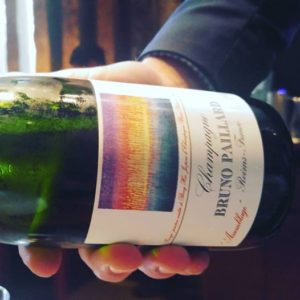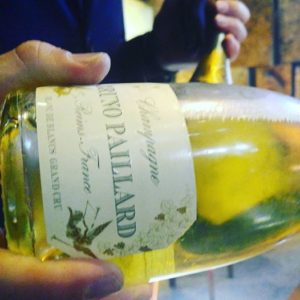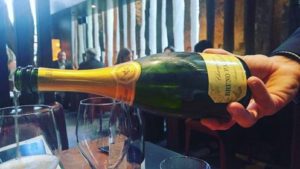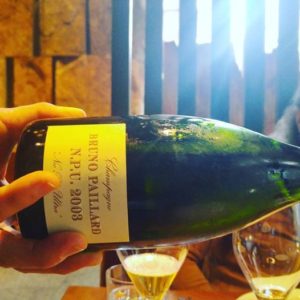 It was truly a wonderful experience to meet Alice Paillard, daughter of Bruno – the founder of Bruno Paillard Champagnes. I have always admired their Champagnes for their tendency to over-deliver in quality, as well as Bruno himself as being a living legend making Champagnes that are sought after by serious connoisseurs even though he faced strong competition from larger, more well-established Champagne houses. Alice had the same passion that I imagined her father possessed. I had a thrilling lunch, often times forgetting to eat my food, as I was drawn into her exuberant explanations of their philosophies with regards to making these lovely Champagnes. One philosophy, in particular, stood out to me – their philosophy of disgorgement.
It was truly a wonderful experience to meet Alice Paillard, daughter of Bruno – the founder of Bruno Paillard Champagnes. I have always admired their Champagnes for their tendency to over-deliver in quality, as well as Bruno himself as being a living legend making Champagnes that are sought after by serious connoisseurs even though he faced strong competition from larger, more well-established Champagne houses. Alice had the same passion that I imagined her father possessed. I had a thrilling lunch, often times forgetting to eat my food, as I was drawn into her exuberant explanations of their philosophies with regards to making these lovely Champagnes. One philosophy, in particular, stood out to me – their philosophy of disgorgement.
Disgorgement
I want to give a brief explanation of disgorgement for those of you who may not be used to this term. Champagne is a wine that is not only about a specific place, aka terroir, but it is also about a particular process of winemaking that needs to be executed with great skill. After a second fermentation in individual bottles, which helps to create the bubbles, there is a time when the bottles are left to age so autolysis, aka lees aging (wine lees are the sediment from the dead yeast cells), can add more complexity to the Champagne. This process may take anywhere from 15 months to up to a decade.
Disgorgement is when the producer removes all the sediment from the bottle. After disgorgement, the wines are given a dosage (wine that equals the quality of what is in the bottle plus very pure cane sugar) which not only helps to make up for the volume of wine that was lost during disgorgement, but also balances out the fierce acidity that is typical in Champagne. Hence, when someone asks what the “dosage” is for a given Champagne, they are asking how much residual sugar is in that bottle.
Life is like an Operation
 Let us get back to the word disgorgement. During my lunch with Alice Paillard, she explained to me that cellar workers used to use the French word meaning “to operate” when they were talking about disgorging bottles. This is the first time that I had heard this term, which seemed odd figuring how long I have been involved in the wine industry, and certainly meeting Champagne producers, that I had to have heard this story sometime in the past.
Let us get back to the word disgorgement. During my lunch with Alice Paillard, she explained to me that cellar workers used to use the French word meaning “to operate” when they were talking about disgorging bottles. This is the first time that I had heard this term, which seemed odd figuring how long I have been involved in the wine industry, and certainly meeting Champagne producers, that I had to have heard this story sometime in the past.
But I must admit it was the first time I had consciously heard it. Maybe it was the passionate way that Alice expressed the importance of seeing it as an operation – the trauma, the shock, the recovery needed for the wines. Maybe it was the idea that I was in a place in my life where I was open to hearing this idea. Or probably it was both.
When I look back on my life, especially during my 20s and 30s, there was so much running around trying to pay bills and take care of people; trying to be everything to everyone – it takes its toll. That inner sparkle started to diminish – not overnight – but slowly, and one day I woke up and said to myself, “What happened to me?!”
Life is like a series of operations, disgorgements, where we have been through some type of intense stress, shock to our system, and we need the time for recovery – even though we may have pressure from the outside world to never stop.
The Maillard Reaction
 Alice Paillard said that it was vital for them to allow their bottles to recover after their operation. This recovery time is dependent on how long they were aged on lees, and so, their general practice of recovery is as follows: minimum of 5 months for Première Cuvée and Rosé Première Cuvée, 8 months for Blanc de Blancs Grand Cru, 8 to 12 months for vintage wines, and up to 18 months for N.P.U. (Nec Plus Ultra).
Alice Paillard said that it was vital for them to allow their bottles to recover after their operation. This recovery time is dependent on how long they were aged on lees, and so, their general practice of recovery is as follows: minimum of 5 months for Première Cuvée and Rosé Première Cuvée, 8 months for Blanc de Blancs Grand Cru, 8 to 12 months for vintage wines, and up to 18 months for N.P.U. (Nec Plus Ultra).
I have read in the past that aging after post-disgorgement was necessary for the Maillard reaction (in Champagne terminology, Reaction Maillard) to happen. I know I’m dropping a lot of crazy terms in this post but this is simply a reaction of sugars and amino acids in the wine that, some believe, create the toasty and roasted goodness present in Champagne wines, as well as other complex aromatics that have not been exactly pinpointed.
Recovery from Life
And so the concept of Champagne needing a little rest before being consumed was not foreign to me, but using the language of “operation” and “recovery” hit me in that moment as truly understanding the importance of this practice.
All of us go through periods in our life where it is impossible to properly take care of ourselves. We experience times like this more and more as we get older. But I think we can get into such a habit of sacrificing our own well-being for so many reasons, that when we do have time to take care of ourselves, we feel guilty about taking that precious time to allow ourselves to be happy. A few months ago, for the first time, I sat for 15 minutes in a little park that I have lived by for over 12 years. I had to force myself to relax and enjoy but once I allowed myself to just sit there, looking at the birds and deeply breathing, I felt new again.
Maybe I had heard the terms “operation” and “recovery” with regards to Champagne before this lunch, but I was in a place in my life where taking care of myself, or at least in my mind, was not an option.
We have to actively give ourselves the time to recover just like Champagne Bruno Paillard gives their wines the rest that they need. And so, I thought, what better way to celebrate having the strength and courage to take care of myself than by drinking a Bruno Paillard Champagne while sitting on my couch with my partner in crime, being grateful for a moment of recovery.
****************************************************
Tasting of Champagne Bruno Paillard with Alice Paillard on October 7th, 2016
Multi-Vintage Champagnes
Bruno Paillard prefers to use the term “multi-vintage” instead of “non-vintage” because they have been using “reserve wines” (wines placed aside from other vintages) since 1985, as well as using a large amount ranging from 20 to 50% in the blend. The large amount of various vintages used truly makes these wines “multi-vintage” Champagnes.
The three following Multi-Vintage Champagnes have a blend of 25 different vintages.
 -Blanc de Blancs Grand Cru: 100% Chardonnay, as indicated by the term “Blanc de Blancs” on a Champagne bottle. The grapes are sourced from grand crus vineyards in the Côte des Blancs, an area of vineyards in Champagne that is highly prized for great Chardonnay. A linear body with lots of energy, a hint of lime blossom yet the very fine bubbles create a creamy texture that balances well with the marked acidity.
-Blanc de Blancs Grand Cru: 100% Chardonnay, as indicated by the term “Blanc de Blancs” on a Champagne bottle. The grapes are sourced from grand crus vineyards in the Côte des Blancs, an area of vineyards in Champagne that is highly prized for great Chardonnay. A linear body with lots of energy, a hint of lime blossom yet the very fine bubbles create a creamy texture that balances well with the marked acidity.
 -Première Cuvée: 45% Pinot Noir, 33% Chardonnay and 22% Pinot Meunier (20% spent first fermentation in barrel). Extra Brut dosage with less than 6 g/l residual sugar. Lots of generous fruit with cranberry and golden apple that has a hint of purple flowers and broader on the palate than the Blanc de Blancs.
-Première Cuvée: 45% Pinot Noir, 33% Chardonnay and 22% Pinot Meunier (20% spent first fermentation in barrel). Extra Brut dosage with less than 6 g/l residual sugar. Lots of generous fruit with cranberry and golden apple that has a hint of purple flowers and broader on the palate than the Blanc de Blancs.
 -Rosé Première Cuvée: Majority Pinot Noir with a small amount of Chardonnay (amount remains a secret). A simply pretty Rosé Champagne with a stunning pale salmon color that hinted to the beautiful yet delicate wild strawberry fruit on the palate, with a touch of sweet spice on the finish.
-Rosé Première Cuvée: Majority Pinot Noir with a small amount of Chardonnay (amount remains a secret). A simply pretty Rosé Champagne with a stunning pale salmon color that hinted to the beautiful yet delicate wild strawberry fruit on the palate, with a touch of sweet spice on the finish.
Art and Vintage Champagnes It can be difficult to express the experience of drinking a particular wine. We try with language using words that people can relate to with regards to aromas, flavors and texture. But I was thrilled to talk to Alice Paillard about their Art series for their Vintage Champagnes. Once they have tasted the Vintage Champagnes, once ready to access, they work with an artist to design the label to help express the main character of the wine.
 -2006 Blanc de Blancs: Swedish artist Jockum Nordström created a collage/painting for this wine under the title Voluptuous, a theme the Paillard family decided on because of the wine’s generous and round character. Smooth and silky in the mouth with flavors of peach pastries and marzipan, with a long, flavorful finish.
-2006 Blanc de Blancs: Swedish artist Jockum Nordström created a collage/painting for this wine under the title Voluptuous, a theme the Paillard family decided on because of the wine’s generous and round character. Smooth and silky in the mouth with flavors of peach pastries and marzipan, with a long, flavorful finish.
 -2008 Assemblage: Korean artist Bang Hai Ja designed this powerful label using the theme Energy. This vintage is completely different from the 2006 with its intense vitality, a dominance of chalky minerality notes and incredible precision.
-2008 Assemblage: Korean artist Bang Hai Ja designed this powerful label using the theme Energy. This vintage is completely different from the 2006 with its intense vitality, a dominance of chalky minerality notes and incredible precision.
 -2003 N.P.U: N.P.U. stands for “Nec Plus Ultra” and represents the most exceptional vintages. 2003 is only the 5th vintage to be released on the market that has been given the prestigious title of N.P.U., as well as 1990, 1995, 1996 and 1999. The 2003 first seemed like an odd vintage with shockingly high temperatures in France during the summer, and so it remains a unique vintage in Champagne that many disagree on with regards to quality. But this 2003 N.P.U. had delicious flavors of honeysuckle, roasted hazelnuts and a rich, creamy texture, yet still had great tension and energy; zesty acidity and an underlying note of minerality came across on the superb, refined finish.
-2003 N.P.U: N.P.U. stands for “Nec Plus Ultra” and represents the most exceptional vintages. 2003 is only the 5th vintage to be released on the market that has been given the prestigious title of N.P.U., as well as 1990, 1995, 1996 and 1999. The 2003 first seemed like an odd vintage with shockingly high temperatures in France during the summer, and so it remains a unique vintage in Champagne that many disagree on with regards to quality. But this 2003 N.P.U. had delicious flavors of honeysuckle, roasted hazelnuts and a rich, creamy texture, yet still had great tension and energy; zesty acidity and an underlying note of minerality came across on the superb, refined finish.











